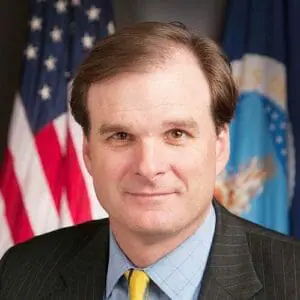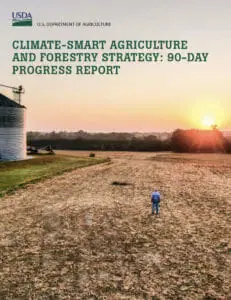By Cam Petersen, M.S. in Sustainable Food Systems student
Our cohort spoke with Robert Bonnie, President Biden’s nominee to be Agriculture Under Secretary for Farm Production and Conservation, on a sunny Friday, July 23, 2021. The conversation was remote, as things tend to be nowadays, and Robert Bonnie spoke to us from his office at USDA.
Bonnie carried himself with the calm demeanor that we’ve all come to expect from individuals hailing from the South -- a credential he solidly holds, growing up on a farm in Kentucky. But he also displayed the signs of someone who is deeply passionate about their subject area, which is a quality that only comes from decades of commitment to a cause.
The dialogue opened with a brief introduction on his current predicament as acting Under Secretary. Having not been fully confirmed by the Senate Agriculture Committee, he had been working in limbo, not fully assured of his position, but ever focused on the role. He quickly cited the USDA’s Climate 21 project and the goal that agriculture and forestry could provide 10-20% of the additional sequestration and emissions reductions needed to achieve net-zero emissions in the United States by 2050, and that it would be “hard to get there without thinking about land and both agriculture and forestry.”
The first several months of his time as acting Under Secretary had been spent responding to the executive order put in place by the Biden administration in late January, which asked USDA to conduct outreach to the agriculture and forestry industries about how the agency can best advance climate-smart agriculture policies.
This led to the release of a report in May on a Climate-Smart Agriculture and Forestry Strategy that goes through numerous policy interventions, of which Bonnie broke down into three parts:
- On the agriculture side, we need to think about significant investments in science and technology, always considering how we look towards the future.
- We must think about how to use existing programs to their fullest extent. Many great results have been achieved with the Environmental Quality Incentives Program (EQIP) and the Conservation Stewardship Program (CSP).
- How can we incentivize climate-smart agriculture on forestry and agriculture working lands? Cover crops, soil health, improved grazing and forestry practices are all examples of where this has been successful. There is a lot we can do in this respect on the conservation and rural development side.
With each of these items, Bonnie stressed that we must consider ways we can improve private investment. There is abundant consumer demand in low carbon products, and emerging markets in greenhouse gas reduction provide opportunities for climate-smart agriculture. How can we subsidize these efforts and invest in the monitoring and evaluation side, in turn making sure that the public is aware and supportive of these programs?
There is a lot of talk about mitigation, Bonnie said, but the resilience angle is incredibly important, and we really don’t have all of the tools that we need to address it. To take drought as an example, we need an instrument to help producers in the short term to fallow land due to water shortages. In other parts of the country, severe flooding and hurricanes are the problem. Mitigation makes sense for some, but maintaining productive operations in the face of climate change might be the answer for others. In other words, it’s all about resilience. Bonnie hit hard on this idea of how the USDA, as an agency, can provide producers with science and information in order to make informed decisions with regards to climate change.
After Mr. Bonnie’s introductory statements, we opened the conversation to questions. Isabelle Yoder asked, how can the government build more incentives for private investment and is it going to be consumer driven? Bonnie weighed in saying that most of our conservation programs are cost-share models that essentially promote private investment. Rewarding investment is already built into the system, but we have to think about this is new ways. What are the tools we harness to incentivize this kind of effort? We’ll also have to utilize the monitoring and evaluation part of this-- people are going to have to know that there are real gains to be had by utilizing these programs, and they have to have an accurate gauge on the risks associated with these practices. Bonnie speculated whether there were ways for USDA to share that risk.
Another member of our certificate program, Stu Lourey, asked how Bonnie and the USDA think about the challenge of rented land, and how to build resilience in that respect. Speaking to the forestry side, Bonnie answered by saying that forestry land -- and especially industrial forestry lands -- change ownership frequently. USDA’s work gets a lot easier when they operate at scale and can track lands as they come in and out of the system, which is inevitable. You’ve got to be able to track land to create incentives to keep carbon in the environment, whether that means in trees or in the soil.
Being a forester, it was inevitable that our conversation touched on the current situation with fires out West. Adding in the equally daunting topic of climate change, it didn’t take the most observant student to notice that there is a lot of work to be done with regards to agriculture and forestry’s role in averting future environmental challenges. When asked by Kathleen Merrigan, Executive Director of the Swette Center for Sustainable Food Systems, how current and future students should persevere in the face of adversity, Bonnie replied that he’d been working at this since the 1990s and that hope is an important ingredient. He also highlighted that we have many promising innovations, like animal feed that greatly reduces methane output, and slow-release nitrogen fertilizers which can prevent excess nutrient runoff. But perhaps the most salient tactic that Bonnie shared came from something one of his former coworkers used to tell him. Innovative technology and unwavering optimism aside, four words outline the true motto for implementing sustainable solutions to climate change: “endless pressure, endlessly applied.”
Robert Bonnie has yet to be confirmed by the Senate, but he and the Honorable Xochitl Torres Small (nominated for Under Secretary of Agriculture for Rural Development) underwent a nomination hearing on Thursday, July 29, 2021 where they were warmly received. Votes for their confirmations have yet to be scheduled.
This blog is part of a series from the July 2021 Washington D.C. Immersive program of the Food Policy and Sustainability Leadership Graduate Certificate Program. Students met with federal food and agriculture focused officials at USDA, the White House and other agencies, Congressional leadership, industry leaders and other important policy stakeholders.

